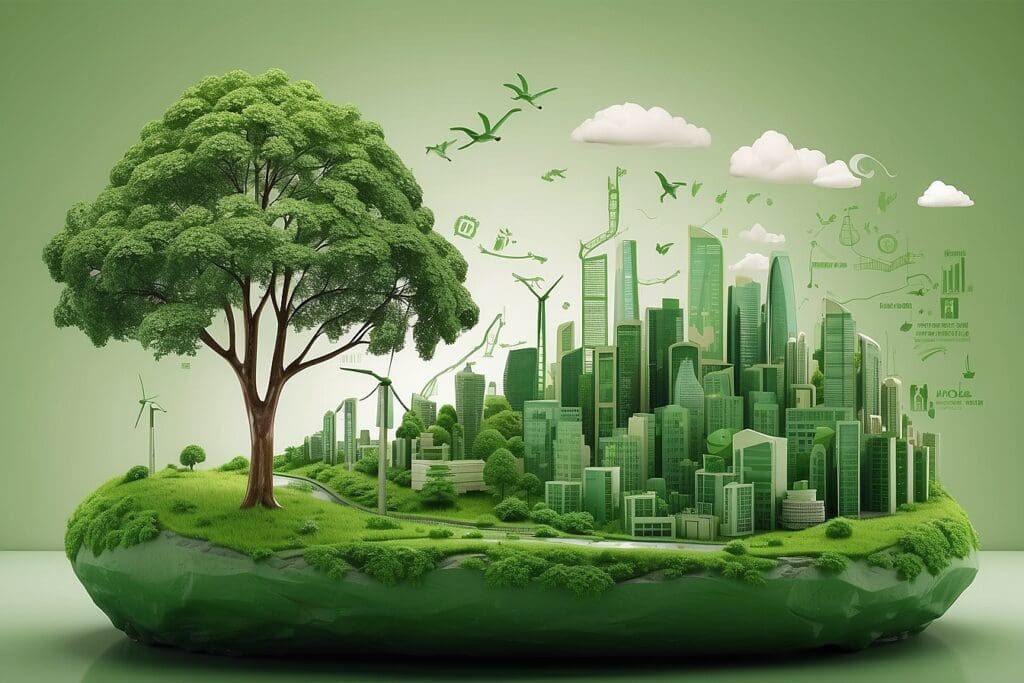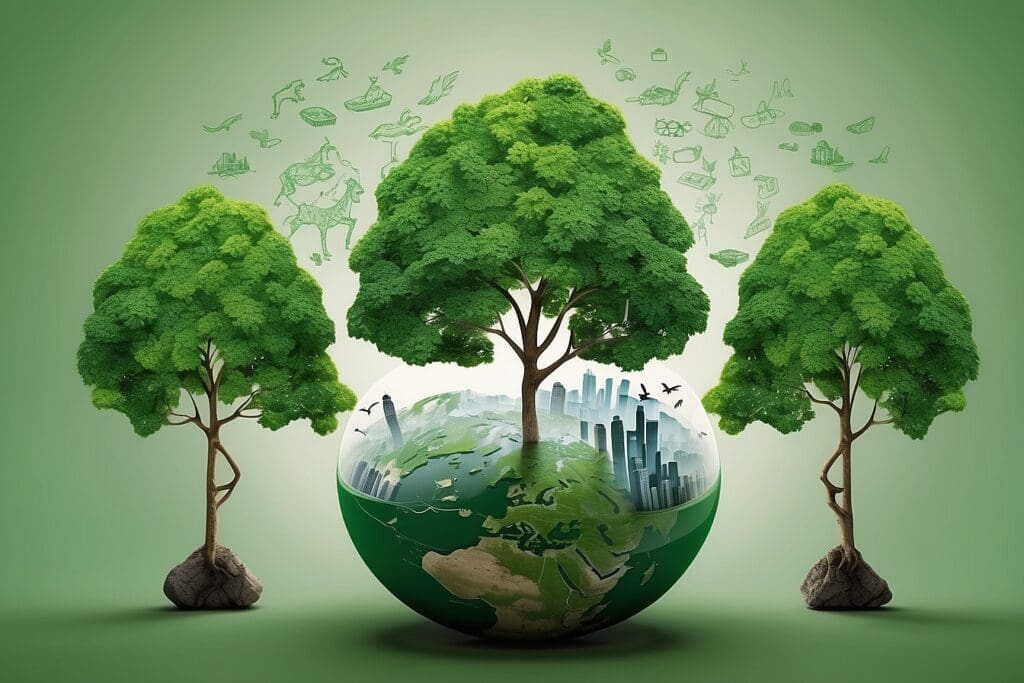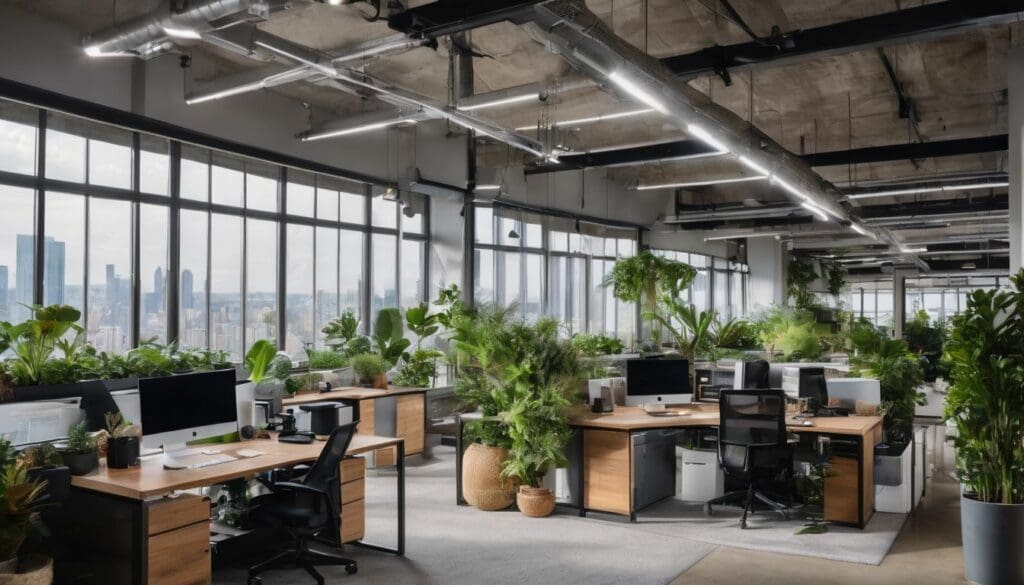Businesses are under pressure to reduce their carbon footprint. In recent years, sustainable practices have surged by over 71%, highlighting a shift towards green business models. This article will explore the transformation from traditional to eco-friendly strategies, benefiting our planet and your pocket.
Let’s dive in and grow green together!
Key Takeaways
- Sustainable business practices have grown since the environmental movement of the 1960s, with companies now integrating green strategies such as renewable energy and waste reduction into their models.
- Green product design, collaborative consumption, and viewing waste as a valuable resource are key components of innovative green business models that reduce environmental impact while meeting consumer demands.
- The future success of businesses is tied to sustainable development; ethical considerations like closed-loop production and organic materials usage are crucial for creating eco-friendly products and services.
- Prosumers contribute significantly to sustainability by engaging in co-creation with companies to develop environmentally friendly products that align with conservation-minded values.
- Green supply chain management reduces carbon footprints and promotes corporate responsibility by ensuring ethical sourcing of raw materials and minimising waste in production processes.
Evolution of Green Business Models and Sustainability

Green business models and sustainability have roots in the environmental movement of the 1960s, but have since evolved to become a major focus for businesses across the globe. This evolution has seen a growth trajectory driven by changing consumer demands and technological advancements, leading to innovative concepts such as green product design, collaborative consumption, and waste as a resource.
Historical Roots
The foundations of green business models stretch back to the early days of environmental awareness and corporate responsibility. In the 1960s, visionaries began advocating for a shift in how businesses impact the environment.
This period saw the birth of concepts like sustainable development and eco-friendly practices, which later evolved into comprehensive sustainability management strategies. Companies started recognising that long-term success depended on more than profits; it required investment in renewable energy sources, lower resource consumption, and minimising harmful environmental footprints.
This push towards environmentally responsible business coincided with societal changes. As people became more conscious about conservation and environmental stewardship, they demanded products that aligned with these values.
Firms responded by integrating principles of the circular economy into their operations — reusing materials and reducing waste wherever possible. Environmental entrepreneurship sparked new markets as innovators developed technologies to address ecological challenges.
Today’s ethical business practices owe much to those early efforts at forging a balance between commerce and nature’s preservation, laying down a path for future green transformation within industries worldwide.
Growth Trajectory
Green business models have been on a steady upward trajectory over the years, driven by an increasing awareness of environmental issues and sustainability. Companies have shifted their focus towards eco-friendly practices, integrating them into their business strategies to minimise their environmental impact while also maximising profitability.
This growth trajectory reflects a shift in consumer demand towards more sustainable products and services, prompting businesses to innovate and adapt to meet these evolving market needs.
The concept of sustainability has evolved from being a mere trend to becoming an essential component of successful business models in today’s eco-conscious world.
The development and adoption of green business models are influenced by various factors such as regulatory compliance, corporate social responsibility, partnership with sustainable suppliers, and the integration of green technology.
Conceptual Architecture
Green business models are built on a conceptual architecture that prioritises sustainability, environmental responsibility, and efficiency. This foundational structure enables businesses to integrate eco-friendly practices into their operations, ensuring that every aspect of the business aligns with environmental conservation efforts.
By incorporating sustainable design principles, renewable energy sources, and waste reduction strategies, companies can create a holistic framework for conducting business in an environmentally friendly manner.
The conceptual architecture of green business models focuses on developing innovative solutions that reduce carbon footprint and minimise environmental impact. It emphasises using resources efficiently, reducing waste generation, and embracing renewable energy sources wherever possible.
Innovative Green Business Models
Innovative green business models, such as green product design and collaborative consumption, have revolutionised the way businesses approach sustainability. These models focus on creating environmentally friendly products and utilising resources in a more sustainable way.
Green Product Design
Green product design integrates sustainable practices into the development of products, aiming to reduce environmental impact. Designing products with eco-friendly materials, efficient energy use, and recyclability is essential for creating a more sustainable future.
It involves considering the entire product lifecycle from material sourcing to disposal, ensuring minimal ecological footprint throughout. Companies embracing green product design are at the forefront of innovation in sustainability, catering to environmentally conscious consumers’ needs while demonstrating corporate responsibility.
Green product design
Prosumers and Co-creation
Prosumers, or proactive consumers, play a pivotal role in the development of sustainable business models. Through their engagement with companies, prosumers offer valuable insights and feedback on green products and services.
Co-creation, involving collaboration between companies and consumers, fosters innovation in sustainability practices. This approach encourages the active involvement of environmentally conscious individuals in the design and production of eco-friendly products, ultimately leading to more effective and impactful solutions for environmental challenges.
By actively participating in co-creation processes, environmentally conscious individuals can contribute towards the development of sustainable business practices. Such collaborative efforts ensure that products align with conservation-minded values while also meeting consumer needs.
Collaborative Consumption
Collaborative consumption, also known as the sharing economy, involves individuals and businesses sharing resources. Companies like Airbnb and Zipcar offer shared access to accommodation and transportation.
Through this model, consumers can reduce their environmental impact by opting for shared services instead of owning individual items or vehicles.
Moreover, collaborative consumption not only benefits the environment but also promotes community engagement and cost savings for users. This business model aligns with the principles of sustainability innovation and eco-friendly business models, contributing to a low-carbon economy while fostering a sense of interconnectedness among communities.
Waste as a Resource
Businesses are increasingly recognising the potential of waste as a valuable resource. Instead of discarding it, they are finding ways to repurpose and recycle waste materials to create new products or generate energy.
This shift towards viewing waste as a resource contributes to the development of circular economy models, where resources are reused and recycled instead of being disposed of after one use.
By adopting this approach, businesses can reduce their environmental impact, conserve natural resources, and contribute to a more sustainable future.
As businesses continue to innovate and develop green business models that leverage waste as a resource, there is an opportunity for individuals to support these efforts through conscious consumption and responsible disposal practices.
Embracing the concept of waste as a resource not only benefits the environment but also encourages greater awareness about sustainable practices in the broader community.
Green Supply Chain Management
Moving from the concept of waste as a resource, green supply chain management plays a crucial role in promoting sustainable and eco-friendly business models. It involves integrating environmentally responsible practices into the sourcing, production, and distribution processes.
Companies focusing on green supply chain management aim to reduce carbon footprint, minimise waste generation, and ensure ethical sourcing of raw materials. By leveraging renewable energy business models and promoting collaborative consumption, organisations can build efficient supply chains that contribute to a low-carbon economy.
Implementing green supply chain management not only aligns with corporate sustainability goals but also fosters a climate-friendly business environment.
Ethical Considerations in Green Business Models

In this section, we will explore the ethical implications of green business models, including product service systems, closed-loop production, and organic and biodegradable production.
These considerations play a crucial role in shaping sustainable and environmentally responsible business practices.
Product Service Systems
Product Service Systems (PSS) are a sustainable business model that emphasises the provision of services rather than selling products directly. This approach encourages companies to design durable and high-quality products, which they retain ownership of and lease to customers.
In doing so, PSS aims to minimise resource consumption, waste generation, and environmental impact while also promoting a more circular economy. Through PSS, businesses can extend product lifecycles by offering repair services, upgrades, and responsible end-of-life disposal or recycling options – all contributing to reducing the overall carbon footprint.
Furthermore, Product Service Systems incentivise manufacturers to adopt eco-design principles for their offerings throughout their entire lifecycle. By encouraging extended product use through sharing or leasing models rather than ownership, this leads to reduced production demands on both natural resources and energy consumption – thereby supporting conservation efforts and contributing positively towards sustainable development goals.
Closed-Loop Production
Closed-loop production emphasises minimising waste and maximising resource efficiency. In this model, products are designed with the intention of being easily disassembled and recycled at the end of their lifecycle.
Materials used in production are selected for their recyclability and reusability, reducing environmental impact. By implementing closed-loop production, businesses can not only reduce their carbon footprint but also contribute to a more sustainable and eco-friendly economy.
This approach helps to usher in a low-carbon economy by ensuring that resources remain in use for as long as possible, thus minimising waste.
The closed-loop production model aims to create a circular economy where materials are constantly reused, ultimately leading to reduced emissions and conservation of natural resources.
Organic and Biodegradable Production
Transitioning from closed-loop production, organic and biodegradable production represents a significant shift towards sustainable business models. Companies are increasingly embracing the use of organic materials in their production processes to reduce environmental impact.
From eco-friendly packaging made from natural fibres to biodegradable cleaning products, businesses are aiming for a low carbon economy by prioritising the use of renewable resources.
Innovations in green chemistry have enabled the development of organic and biodegradable alternatives across various industries, providing environmentally conscious individuals with sustainable choices that support conservation efforts.
Future Outlook and Conclusion
Looking ahead, the evolution of green business models will continue to shape the economic landscape. Businesses must embrace sustainable practices to thrive in a rapidly changing world.
Innovations in green product design and supply chain management will drive the shift towards a more environmentally conscious economy. The future holds promise for businesses that incorporate ethical considerations into their operations, setting the stage for a greener, more prosperous future.
FAQs
1. What are green business models?
Green business models are strategies companies use to operate in ways that benefit the environment, like focusing on green innovation and promoting a low-carbon economy.
2. How have business models evolved to be more environmentally friendly?
Businesses have shifted towards environmental models by incorporating climate-friendly strategies and contributing to the green economy through sustainable practices.
3. Why is adopting a green business model important today?
Adopting a green business model is crucial for reducing environmental impact, meeting consumer demand for sustainability, and helping transition towards a cleaner, greener economy.
4. Can businesses profit from switching to a green model?
Yes, companies can benefit financially from embracing green innovations as they can lead to cost savings in resources and energy whilst attracting customers who value sustainable practices.



